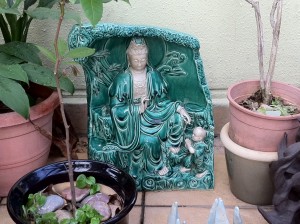 I have recently been working on re-titling and writing notes for some artworks that I completed back in 2005. The first of these, “The Magician” you can see in the image on this page. The image itself is meant as a way of visually connecting to our “Inner Magician”. The inner magician is that part of our inner self that is both creative and magical within us, and that if we harness it effectively has the power to change our daily life and experience for the better.
I have recently been working on re-titling and writing notes for some artworks that I completed back in 2005. The first of these, “The Magician” you can see in the image on this page. The image itself is meant as a way of visually connecting to our “Inner Magician”. The inner magician is that part of our inner self that is both creative and magical within us, and that if we harness it effectively has the power to change our daily life and experience for the better.
So, who or what is our inner magician? Here is a working definition:
“The higher expression of our inner magician is that part of self that is able to work with the higher, deeper and spiritualized expression of magic.”
Magic in this context means the following:
- Being able to affect or change one level of our reality by working on it from the level or plane of reality above it.
- Engaging our creative imagination vividly and consciously to “sculpt” our experience of any given situation for the better.
- Not being content to let good ideas remain in our head, but actively finding ways of expressing those ideas concretely in our daily life.
Let’s take a closer look at these three aspects of magic:
1) Being able to affect or change one level of our reality by working on it from the level or plane of reality above it.
In its simplest terms this means that you use your mind and thoughts to change your physical and emotional reality for the better, and you use your spiritual or intuitive mind (which operates on a level beyond thought) to change your thinking patterns for the better.
A simple example might be this:
– If I experience physical pain because of an injury or illness I use my thinking mind to remain positive, telling myself that the pain won’t last forever, and encouraging myself to practice patience. This is using my thoughts to positively affect my physical reality.
– If I find myself having repetitive negative thoughts about my pain and illness, then I can temporarily suspend my thinking (this is really where meditation comes into the picture) and move into a state of mind beyond thought. Doing this enables me to release the momentum of all the negative thoughts that I was having, so that my mind becomes a “clean slate” so to speak which I can then replace the negative thoughts with more appropriate and affirmative ones.
So this is a very simple example, thinking mind works magic on physical world and emotions, spiritual mind works to affect and control the thinking mind.
2) Engaging our creative imagination vividly and consciously to “sculpt” our experience of any given situation for the better.
We think that there is a concrete reality “out there” waiting to be discovered that has some kind of fixed or inherent qualities. Actually this is not quite the case. What happens is that the “bare facts” our outer reality meets our mind, which then imagines or projects its own ideas onto that outer reality.
From this we can see that what we experience in life has something to do with the “facts” of our life, but equally as much it also has to do with our imaginative response to those facts. To work with magic is to realize the power of your imagination to co-create any given situation in your life, and leverage on that imaginative power effectively. For more on this you can read my past article “Taking your creative imagination as your object of meditation”.
Our imagination is deeply and powerfully magical, it can create great art and great bliss, or it can create our own private hell.
3) Not being content to let good ideas remain in our head, but actively finding ways of expressing those ideas concretely in our daily life.
Our magical self realizes that any good idea that we understand, create or hear about is an INJUNCTION. An injunction is somewhere between an invitation and an obligation. So this means that when we have or hear a great idea we recognize that our understanding of this idea is INVITING us to use the idea as a practical tool with which we can change our life for the better. By virtue of our understanding of the idea we could also say that we have an obligation to try and integrate that idea into our life. If we just let that idea remain in our intellect that would be a great waste right? Many of us are guilty of this; having great insights and ideas about our life, but not implementing them, thus wasting them.
So, our magical self or inner magician is delighted when good idea comes our way and immediately seeks ways to start expressing these ideas in a practical way to change our life for the better.
Practical Work
If you want to follow up on this article on a practical level, here are two suggestions:
1) Use the image above as an object of meditation in order to help you to intuitively connect to your own “Inner Magician”.
2) As soon as you have or understand a good idea intellectually, immediately ask yourself “How can I make this idea a concrete, practical reality in my life?” Do whatever you can to act upon your answer to this question.
© Toby Ouvry 2011, you are welcome to use or share this article, but please cite Toby as the source and include reference to his website www.tobyouvry.com







